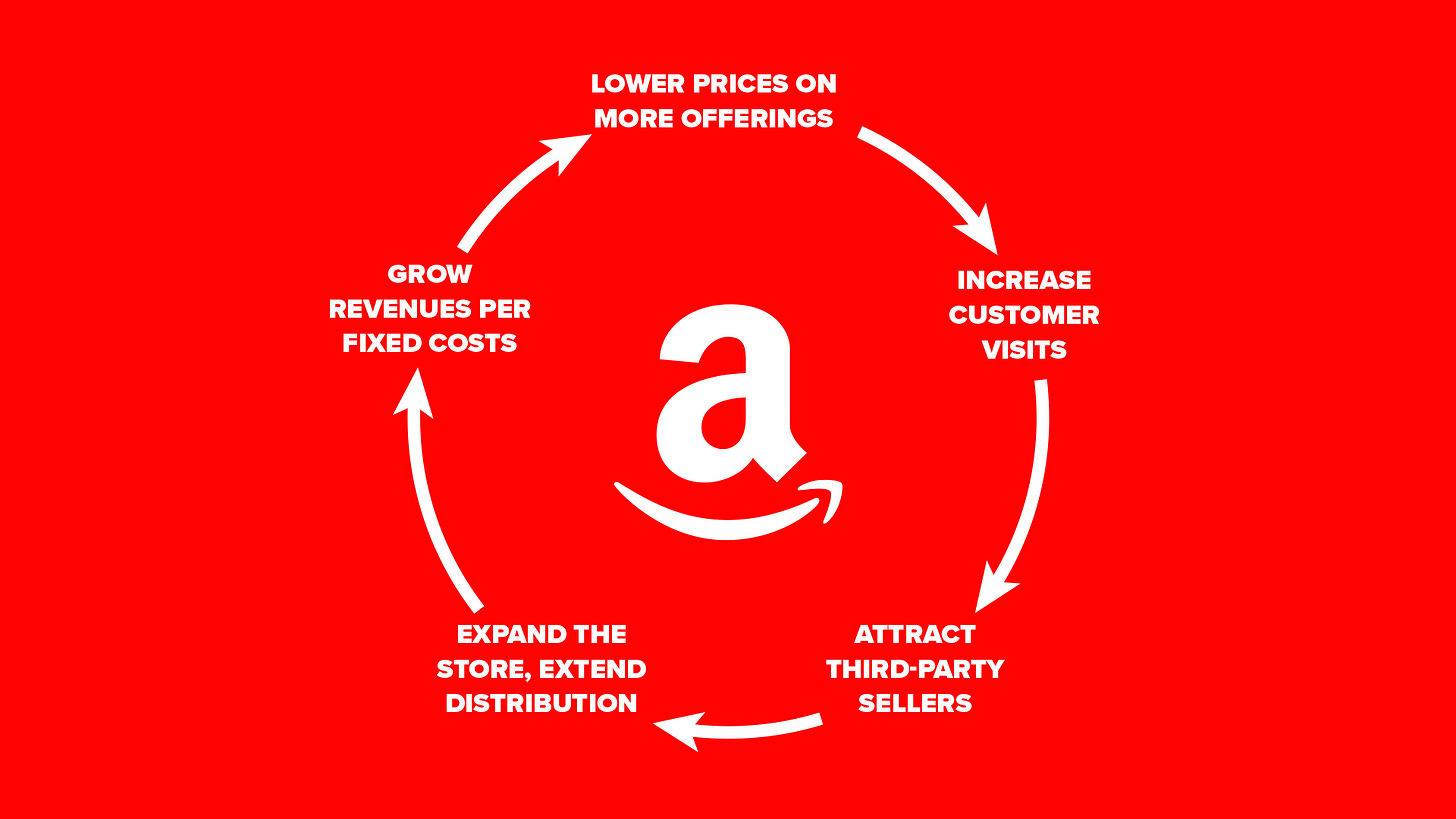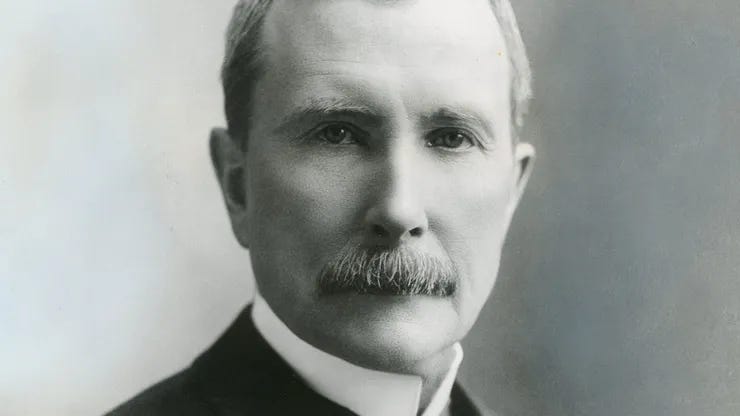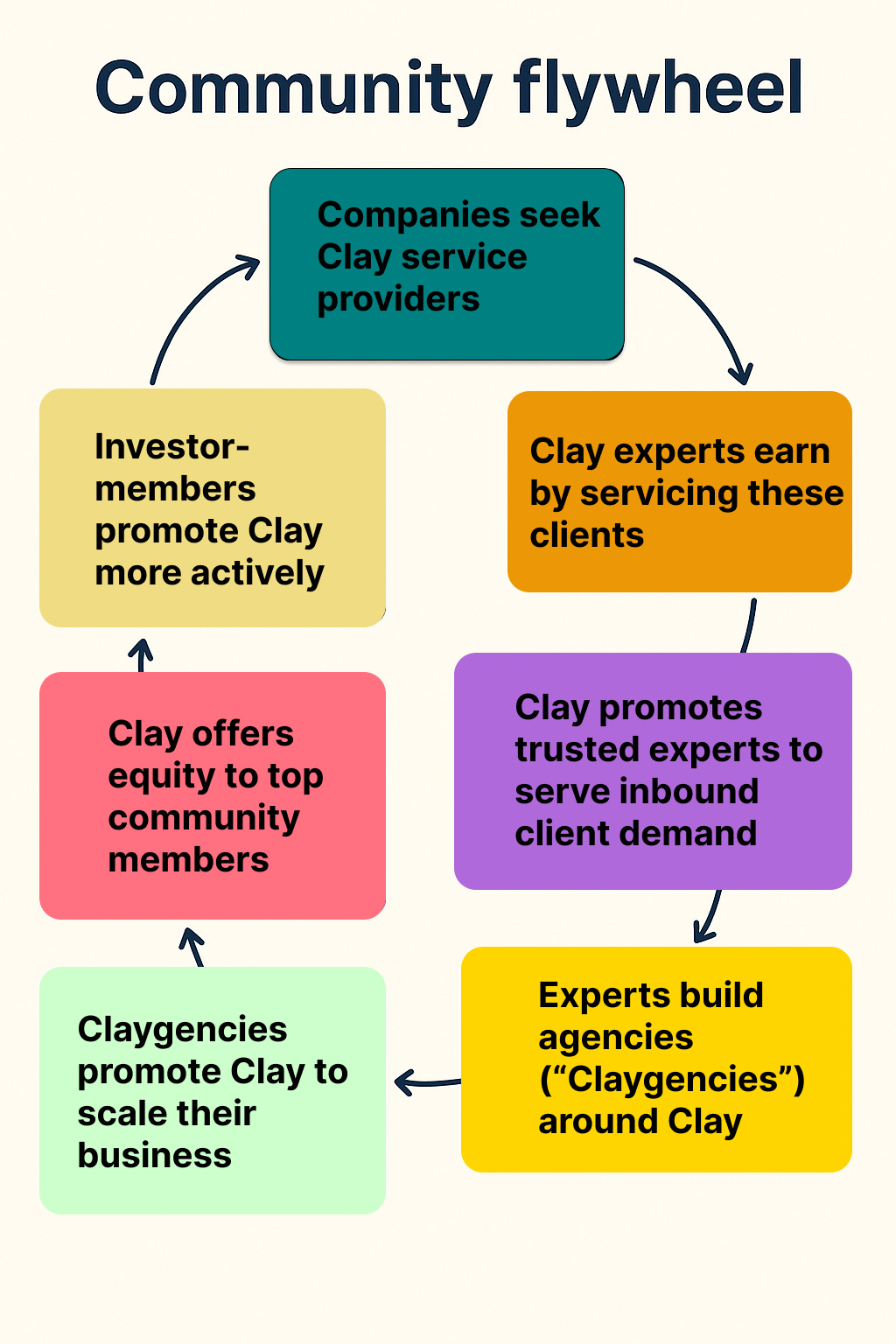When I showed Clay to two of my most technical friends, both were baffled. The first friend, who has a deep knowledge of AI research, stated that Claygent, Clay’s AI agent, was “easily replicable by an undergrad.” The other friend, who learns new tools at lightning speed, said he could “recreate Clay’s functionality within a weekend.” Both were in utter disbelief that Clay had just raised a $40 million series B at a $1.25 billion valuation and even more shocked that I had recently invested in Clay’s community equity offering.
But what if I told you that Clay’s not just the front-runner in the GTM technology space but has such a commanding lead that it will be nearly impossible to dislodge? From my perspective, this is far less about Clay’s technology and more about its brilliant GTM strategy, which leverages multiple flywheels to create an overwhelming growth engine. In this article, I cover six flywheels and how they power Clay’s market domination. Anyone not interested in reading the full article can find a summary here.
What is a Flywheel?
The term flywheel was first coined by author Jim Collins in his 2001 book, “Good to Great.” A flywheel is a self-reinforcing loop where momentum builds over time, making growth more efficient and sustainable as each part of the system feeds and strengthens the others. Most highly successful companies have one (or often, multiple) flywheels working in their favor, and the concept was a core part of Amazon.com’s strategy, enabling them to dominate their market. I go into more detail about different types of flywheels in my article on moats.
Clay Flywheel #1: UGC flywheel
In this article, B2B startup expert Elena Verna makes a compelling case that user-generated content (UGC), and most notably user templates, will fuel massive SEO growth for future startups. Notion, Amplitude, Figma, and other startups prove her point, and Clay has taken a page from their playbook, creating a powerful SEO growth engine in the process.
Traditional SEO is very costly in terms of time and money. The SEO juggernaut, Hubspot, had a team of 40 freelance writers producing over 800 pieces of content per year. By getting users to create templates on their behalf, Clay has managed to outsource the work while retaining all the benefits.
Clay Flywheel #2: Data flywheel
While I call this the “Data flywheel,” it is a sub-category of the “Economies of scale flywheel.” With this flywheel, a company accumulates size, enabling it to command more volume, giving it greater pricing power, and destroying the competition, leading to even more size. It is one of the most classic flywheels and has been exploited by everyone from Standard Oil to Walmart.
Clay has partnerships with various data providers, enabling you to pick and choose which providers to work with to enrich your data. However, because of Clay’s current size and market position, even if a new competitor could build the same data provider relationships that Clay has, they would still be unable to match Clay’s pricing power, leaving them at a distinct disadvantage.
Clay flywheel #3: Education flywheel
Clay has done a fantastic job putting together a robust, cohort-based training program led by my friend Yash Tekriwal. I went through this training in July 2024 and found it to be a good mix of classroom learning and hands-on experience. While the training is free, Clay does benefit long-term from it, as it gets more users to sign up for Clay, promote it to their networks, and, by doing so, drive additional sign-ups for training.
Clay flywheel #4: Social media flywheel
Clay’s employees are very active online and on social media. Whenever I log in to LinkedIn, I see at least five Clay employees or community members posting news about Clay, new features Clay is offering, how-to guides on Clay, and more. Many Clay employees also write Clay or GTM-related newsletters, such as Claymation by Alex Lindahl or Engineering Revenue by Ashley Artrip (both are fantastic).
While I am sure Clay’s employees genuinely enjoy working there and sharing their insights, I also think it’s extremely likely they are encouraged by Clay to promote the company consistently on social media and online. This strategy has been well-executed by B2B giants like Gong, and while anyone could copy it, I feel that Clay has done it exceptionally well (note: when I say “users” below, I mean “Clay users”).
Clay flywheel #5: Community flywheel
Many thought leaders in the GTM space, such as Greg Isenberg, speak constantly about the power of a large and engaged community. Typically, brands will post heavily on social media, identify the users who respond with the most enthusiasm, and then pull these individuals into private groups, giving them more power and a shared stake in the company’s success.
Clay, a paid B2B tool with a relatively steep learning curve, has the added benefit of enabling its users to earn money by servicing clients who need it. As a result, they have built up a unique community strategy in which their most loyal fans build agencies (which they call “Claygencies”) to service the needs of Clay prospects, and Clay promotes these Claygencies, rewarding them for their loyalty.
In addition, Clay recently opened up a community equity round, which I invested in. By encouraging community members to build Clay-centric agencies and then enabling them to get a piece of equity in Clay, they have created a win-win that aligns their incentives perfectly with those of their community.
Clay flywheel #6: Certification flywheel
As Clay has become a more popular tool with a broader range of clients, I have seen job posts requesting expertise with Clay. The training cohorts Clay has created are perfectly designed for job seekers to develop that expertise. Once they’ve accomplished the training, they will undoubtedly share what they have learned online, promoting Clay further.
Conclusion
It’s easy to look at Clay, scoff at the tech, or even question the valuation. But to do that is to completely miss the point. Clay isn’t winning because of some groundbreaking technical moat. It’s winning because it understands how to build momentum.
Each of Clay’s six flywheels - UGC, data, education, social, community, and certification - feeds into the next, creating a compounding advantage that’s incredibly hard to replicate. It’s not just about the product. It’s about the ecosystem. In today’s GTM landscape, distribution often beats innovation. And Clay is a masterclass in building distribution engines that scale.
If you liked this content, please click the <3 button on Substack so I know which content to double down on.
TLDR Summary
Despite skepticism from technical peers, Clay’s dominance in the go-to-market (GTM) tech space is less about breakthrough technology and more about its strategic use of distribution flywheels. These six interlocking flywheels create a compounding advantage that’s incredibly difficult to replicate.
Key Points and Insights
1. UGC Flywheel – User-Generated Templates Drive SEO
Clay leverages user-submitted templates to scale SEO, similar to Notion and Figma
Gains content volume without in-house investment, turning users into distribution channels
2. Data Flywheel – Economies of Scale on Enrichment
With scale, Clay negotiates better data pricing and deeper integrations
Competitors can't easily replicate these economics, creating a long-term moat
3. Education Flywheel – Cohort-Based Training
Free, hands-on training cohorts drive product adoption and word-of-mouth
Trainees often become advocates, bringing in new users organically
4. Social Media Flywheel – Employee and Community Amplification
Clay encourages employees and users to post about their product experiences
Consistent visibility across platforms like LinkedIn builds awareness and trust
5. Community Flywheel – Claygencies and Community Equity
Power users create Clay-focused agencies, which Clay supports and promotes
Community equity aligns incentives, turning users into long-term partners
6. Certification Flywheel – Skills That Signal Value
Certifications help users land jobs and showcase skills
Each certification shared online is a viral loop that reinforces Clay’s credibility
Conclusion
Clay isn’t winning because it built the most advanced tech. It’s winning because it understands how to build momentum. These six flywheels reinforce each other and create a distribution machine that outpaces innovation alone.
In today’s market, distribution often beats product. Clay is a masterclass in scaling through strategy.
















Such a powerful tool!